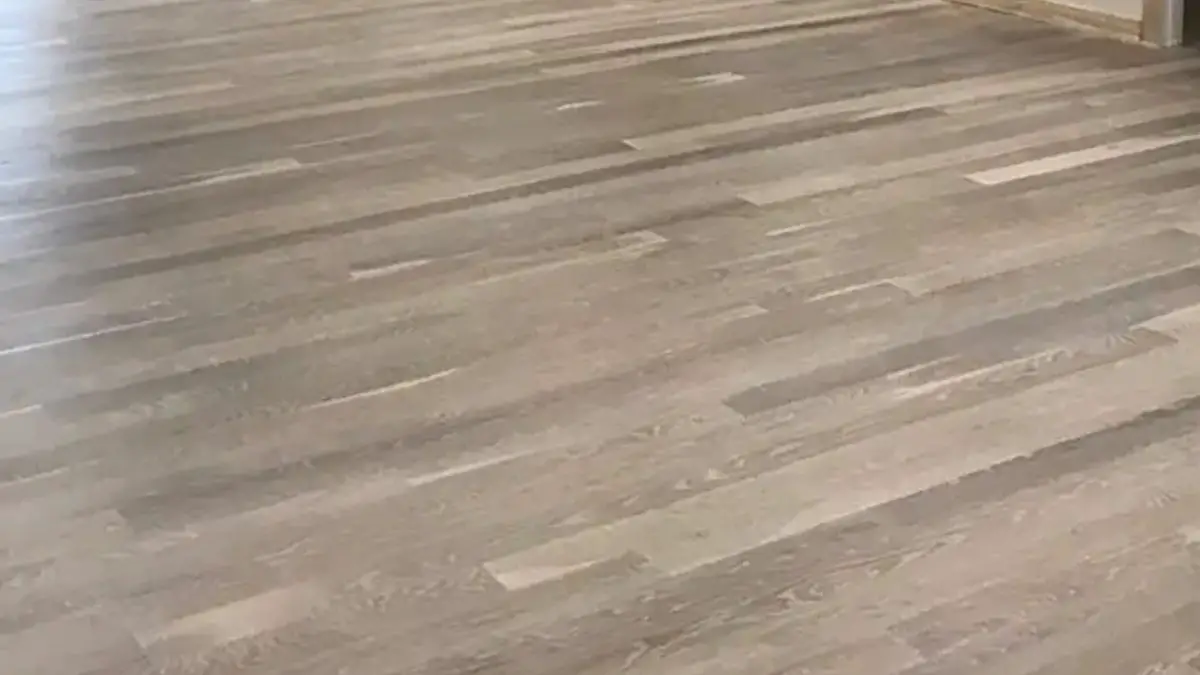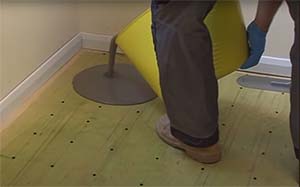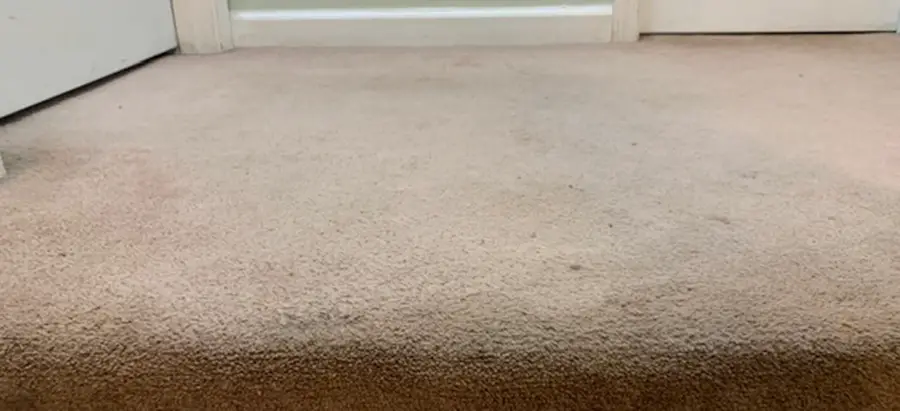
Carpet has been one of the most popular flooring options in homes for decades. New carpeting carries a luxurious feel as you allow your feet to sink into the soft carpet. But, similar to any other flooring, it won’t last forever. As carpeting ages, it will need to be replaced due to wear and tear.
Carpeting lasts 5 to 15 years on average. Carpet lifespan depends on the material, padding, foot traffic, and cleanings. Carpet in high traffic areas will last about 5 to 10 years, while carpet with less foot traffic can last 15 to 20 years. You should replace the carpet within 15 years regardless of material due to everyday wear, ground-in dirt, and aging padding. Even the best carpet padding will wear out within 15 years.
Replacing your carpet takes priority as it was not supposed to last long. The damage done by constant use and the lingering stains and odors stuck on your carpet can degrade your interior flooring quality. That is why you have to know more about when it is the right time to replace your carpet and properly maintain your carpet.
How Long Should Carpet Last?
When you talk about carpet lifespan, there are plenty of things that need to be considered, mainly because of the variety of carpet materials and household foot traffic. Still, on average, carpets will usually last somewhere between 5 to 15 years. The window between 5 and 15 years seems broad-primarily because many factors need to be considered.
What Carpet is Made From
Carpeting is made of four types of fiber; nylon, polyester, olefin, and wool. For one, carpet life is affected by the type of materials used. Carpets made from more natural materials (such as wool) tend to have shorter lifespans than carpets made using artificial materials like polyester fibers or nylon.
The lifespan of your carpet depends a lot on your choice. You can go with cheaper artificial carpets or more expensive organic options. However, even the best carpeting can wear out quickly under heavy traffic and lack of care.
- Nylon is the most durable and stain-resistant of all carpet fibers. Nylon is the most family-friendly carpet, and it’s well suited for kids and pets in high-traffic areas like hallways and stairs.
- Polyester has a luxurious look and feels underfoot, making it ideal for normal traffic areas like bedrooms.
- Olefin offers excellent stain and moisture resistance, making it well suited for commercial use. Olefin generally has a low pile that resists matting.
- Wool is a premium fiber that resists dirt and can look good for many years. Wool carpets are preferred by many for their beauty and softness.
How Carpet Holds Up To Foot Traffic
Floor traffic is also essential to the longevity of carpeting. Living room carpets are more likely to suffer from the wear and tear of constant use, whereas carpets in bedrooms may be rarely used. Similarly, carpets in homes with children and pets also won’t last very long for obvious reasons.
While the minimum lifespan of a carpet is usually five (5) years, a lot can happen in 5 and 15 years because of the different factors that affect your carpet’s quality. So, if you want to maximize your carpet’s lifespan, proper cleaning and maintenance are essential.
Carpet Life Depends on Padding Too
The padding under your carpet has a significant impact on how long your carpet will last. Choosing premium carpet padding can make even the cheapest carpet last a lot longer. This is especially true in high-traffic areas.
A good quality carpet padding helps with the acoustics in the home as well. It reduces sound and vibration on the floor caused by walking or children playing.
Carpet padding comes in a variety of weights and thicknesses. Let’s look at how padding thickness relates to usage.
- High traffic areas: You’ll want a thinner carpet padding with a heavier weight in heavy traffic areas to sustain the wear better over time.
- Normal traffic areas: You’ll want thicker carpet padding in normal traffic areas like bedrooms and living rooms to provide a more luxurious look and comfort.
How Often Should Carpeting be Replaced?
While carpets generally last somewhere between 5 and 15 years, there are tell-tale signs that you need to replace your carpeting, regardless of age. Check for signs that tell you that you need to have your carpet replaced.
High-quality carpeting should last you 10 to 15 years or more. High-quality carpet is constructed to be long-lasting and withstand wear.
Carpeting that is 20 years old has reached an age where it should be replaced. Carpet that is 20 years old will have dust, dirt, and debris buildup in the fibers and trapped beneath the carpet that can’t be removed. This will cause allergy problems and odors that can’t be removed.
Carpet that is 30 years of age needs to be replaced regardless of quality or appearance. Carpeting that is 30 years old can have mold and mildew trapped beneath the padding on the sub-floor. This is usually caused by repeated cleanings that otherwise should’ve been replaced. Often, cleaning reduces smells for a day or two only to have the stains and smells return a few days later.
When Carpeting Needs to Be Replaced
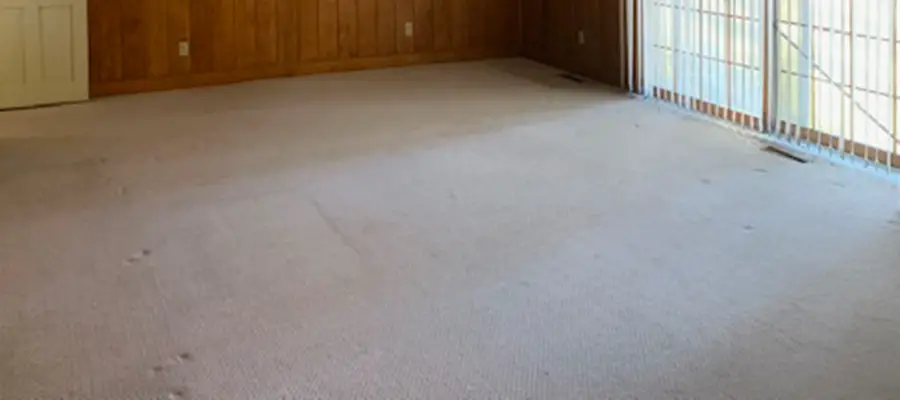
Here are the five key signs you should look out for when determining if you should replace your carpeting:
The Carpet is Permanently Stained
Even if your carpet looks great, permanent stains can change everything. No one wants to look at permanently stained carpeting, especially when you have a light-colored carpet.
There are many different types of stains: oil-based, protein-based, tannin, and dyes. All of those stains tend to leave a permanent stain that is difficult to impossible to remove.
Protein-based stains are caused by food, baby formula, eggs, feces, and urine. Most pet stains are protein-based stains. These stains can be almost impossible to remove when dried completely.
Oil-Based Stains are stains caused by car grease or motor oil, hair products, lotions, salad dressings, suntan oil or lotions, and kitchen grease or cooking oils.
Tannin Stains are caused by drinks like coffee, tea, fruit juices, soft drinks, and wine. Tannin is also found in jellies, jams, and fruit preservatives.
Dye Stains are caused by mustard, ketchup, grass, and fruits such as blueberries, blackberries, and cherries. Dye stains are tough to remove.
The Carpet Fibers are Matted
Matting is when the fibers are pressed down on the floor instead of standing right back up. Matted carpet fibers lose their ability to stand back up age and use, usually in high-traffic areas like hallways and stairs. Once the fibers begin to mat, you usually can’t do anything to restore them. Matting doesn’t depend too much on age but more on foot traffic.
So, when your carpet begins to become matted, you should consider replacing the carpet.
The Carpet Smells Bad
Some carpets tend to carry lingering odors from spills, pets, or the buildup of mold or mildew on subflooring from repeated shampooing. In some cases, no matter how hard you clean your carpet, the bad odor won’t go away, especially if the source of the odor has already penetrated deep into the inner portion of the carpet or the padding.
Though your carpet may still look great in some areas with no visible damages, bad smells get trapped deep in the carpet fibers or padding and can’t be extracted.
The Carpet Padding Has Worn-out
Carpet padding is essential to the overall life of carpeting. Carpet padding is the thin layer of cushion that makes the carpet comfortable to walk on or sit on. Carpet padding also serves as a noise buffer to quiet walking on the floor and can prevent echoing inside the house. Once carpet padding has worn out, there is no alternative but to replace it.
Carpet padding comes in three materials; rebond, rubber, and urethane.
Rebond padding is made from recycled chip pieces of foam that are bonded together with adhesive and mesh. Rebond is the most common carpet padding due to its low cost. It’s available in a variety of densities that improves the lifespan. Generally speaking, rebond lasts up to 10 years.
Rubber padding lasts 10 to 20 years but is not as popular due to cost compared to rebond. Rubber is more popular in commercial applications due to how well it withstands high foot traffic.
Urethane padding is a premium carpet padding that lasts 15 to 25 years. Urethane is durable yet soft. Urethane is the most expensive carpet padding and usually a top choice in high-end installations where premium wool carpeting is installed.
Dirty Carpet Causes Allergies and Other Respiratory Issues
Old carpets contain many allergens that can cause allergies, respiratory problems, and skin irritations. This is a lot more common for older carpets, but it can still happen with newer carpets that aren’t routinely vacuumed or cleaned.
Increased allergy symptoms are caused when dirt, dust, and debris become embedded in carpet fibers. No amount of vacuuming or shampooing can remove it. The only remedy is the carpet and padding replacement. If you or your family get sick easily from colds or allergy symptoms, your carpet is likely the culprit if it is old.
Respiratory issues such as a simple cough and runny nose to cold-like symptoms or the flu, and even frequent asthma attacks are common if you have old carpeting. Dirty carpeting can grow mold and mildew underneath the carpeting. Mold produces mycotoxins that contribute to low indoor air quality. Prolonged exposure and severe cases can cause neurotoxicity and hypersensitivity.
Neurotoxicity is the damage to the peripheral nervous system caused by exposure to toxins. Toxins can disrupt the activity of the nervous system and could disrupt or kill nerves altogether.
Skin irritation and infection such as redness, itchiness, swelling, or infection can be caused by old carpeting. Athlete’s foot is a fungal skin condition caused by dirty carpeting. This contagious fungal infection is acquired by walking barefoot on a fungi-infested carpet. If you find that you routinely suffer from athlete’s foot or other skin irritations, the source may be in your dirty carpet.
How Often Should You Clean Carpet?

One way you can prolong your carpet’s lifespan and make sure that it at least reaches the minimum lifespan of most carpets is to take care of it. And there is nothing better for carpet care than cleaning your carpet.
But there are specific methods to follow when cleaning your carpet because of how conventional methods such as brushing can damage the carpet’s structure. That’s why you have to be delicate with your approach and that you should use special carpet shampoos designed to help you clean the carpet thoroughly.
I recommend that you clean your carpet once every three months to ensure that dirt, bacteria, odor, and pests built up are regularly removed. It is difficult to get rid of the dirt built up for months or even years. Every homeowner with carpeting should have an excellent quality carpet shampooer that you can use between professional cleanings.
I own and use a Bissell ProHeat 2X Revolution Max Clean Pet Pro Full-Size Carpet Cleaner. We have three dogs and a cat, and this model has served us well.
How Often Should Carpet Be Professionally Cleaned?
While you can help improve your carpet’s health by regularly cleaning it yourself, you should also have it professionally cleaned once a year. Professional cleaners are specialized equipment that can extract deep dirt buildup that traditional carpet cleaners can’t.
Professional carpet cleaners are also equipped with the knowledge and skill to clean your carpet safely and delicately, which doesn’t shorten your carpet’s lifespan.
I recommend that a family with children have their carpet professionally cleaned once a year. Smaller families without pets can have their carpet professionally cleaned every 2 to 3 years, depending on your home’s environment and the carpet’s foot traffic. Some carpets that are not as exposed to foot traffic and dirt may go without professional cleaning for more than three (3) years, but it is still better to have your carpet cleaned professionally.
How Much Does it Cost to Replace Carpet?
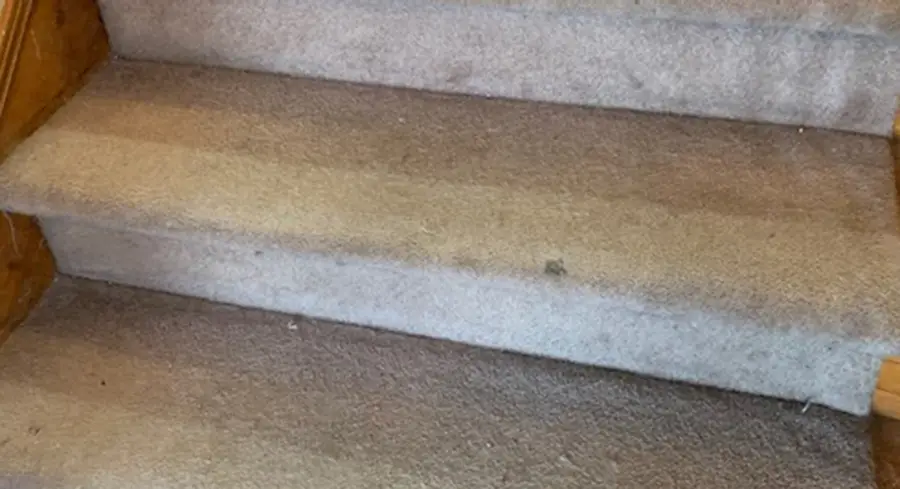
When it comes time to buy new carpeting, you’ll be faced with a lot of choices. There are many types of carpeting to choose from, including pile and carpet quality, to name a few.
According to HGTV, most homeowners will pay $2 to $4 per square foot for good-quality synthetic carpet made with polyester or nylon fibers. Synthetic carpets like these are famous mid-range carpets because they are family-friendly and offer a wide variety of colors, styles, and textures.
Professional carpet installation adds $1 to $2 per square foot in cost. You can expect a total cost for polyester or nylon carpeting with professional installation of $3 to $6 per square foot.
To carpet a standard 12×14 bedroom (168 square feet), you can expect to pay $504 to $1008. If not included, a quality padding can add another $75 to $150 for a standard bedroom.
If you’re looking for wool carpeting, you’ll pay $5 to $12 per square foot. Some luxury wool carpeting can cost upward of $25 per square foot or more.




